Overview
Understanding the causes of type 2 diabetes can feel overwhelming, but it's important to know that you're not alone in this journey. The condition arises from a combination of genetic predisposition, lifestyle factors like obesity and physical inactivity, and environmental influences. Together, these elements contribute to insulin resistance and elevated blood sugar levels.
Recognizing these multifactorial causes is essential for effective prevention and management. By making lifestyle modifications, such as adopting a healthier diet and increasing physical activity, you can significantly reduce your risk of developing type 2 diabetes. Remember, every small step counts, and we are here to support you every step of the way.
If you’re feeling uncertain about where to start, consider reaching out for resources or support groups. Sharing experiences with others can foster a sense of community and understanding, making it easier to navigate this path. You're not alone, and together, we can create a healthier future.
Introduction
In a world where chronic health conditions are increasingly prevalent, Type 2 Diabetes emerges as a significant public health challenge, impacting millions around the globe. This complex metabolic disorder is not just defined by insulin resistance; it is deeply intertwined with lifestyle choices, making its prevention and management all the more vital. With approximately 422 million individuals living with diabetes, understanding the nuances of this condition—from its symptoms and risk factors to effective management strategies—has never been more essential.
It's understandable to feel overwhelmed by the information surrounding diabetes. As healthcare professionals and organizations work tirelessly to combat this epidemic, resources like T2DSolutions serve as crucial platforms for education and community support. These resources empower individuals to navigate their diabetes journey with knowledge and confidence, reminding them that they are not alone in this journey. Together, we can foster a supportive environment that encourages open dialogue and shared experiences.
Understanding Type 2 Diabetes: Definition and Overview
Type 2 diabetes is a chronic metabolic condition characterized by insulin resistance, where the body's cells struggle to respond effectively to insulin. This resistance can lead to elevated blood sugar levels, resulting in serious health complications if not managed properly. Unlike Type 1 diabetes, where the pancreas produces little to no insulin, Type 2 often develops gradually and is closely linked to lifestyle factors such as diet, physical activity, and obesity.
It's concerning to note that Type 2 is the most common form of diabetes worldwide, affecting millions of individuals. Current estimates suggest that approximately 422 million people globally are living with this condition, with Type 2 accounting for about 90% of these cases. This issue is particularly pressing in low- and middle-income countries, where the World Health Organization (WHO) is actively promoting effective measures for surveillance, prevention, and control through initiatives like the Global Diabetes Compact, launched in April 2021.
Recent research underscores the significant role of insulin resistance in the development of Type 2 diabetes. For instance, a study found that 39.5% of adults diagnosed with this condition had non-HDL cholesterol levels of 130 mg/dL or higher, indicating an increased risk for cardiovascular disease, often associated with insulin resistance. Additionally, physical inactivity poses a substantial barrier to effective blood sugar control, with 31.9% of adults with Type 2 participating in fewer than 10 minutes of moderate or vigorous exercise weekly. This statistic highlights the urgent need for enhanced physical activity programs to address the rising health issues related to diabetes.
In Tunisia, the impact of this condition is evident in the Disability-Adjusted Life Years (DALY) count, which stands at 152,000. This figure reflects the considerable burden of diabetes on public health in the region.
Sir Zumla, a UK-NIHR Senior Investigator, emphasizes the importance of addressing diabetes care. He states that effective strategies are vital for improving health outcomes. Understanding the causes of Type 2 diabetes, along with its characteristics and risk factors, is essential for prevention and management. It's important to know that this condition is often preventable through lifestyle modifications, such as adopting a balanced diet and increasing physical activity. Many people wonder what causes Type 2 diabetes, and recognizing the signs and symptoms early can empower individuals to take proactive steps to mitigate their risk and enhance their overall health.
You're not alone in this journey. By seeking support and resources, you can make informed decisions that positively impact your health.

Recognizing the Symptoms of Type 2 Diabetes
Common symptoms of Type 2 Diabetes, such as increased thirst, frequent urination, extreme hunger, fatigue, blurred vision, and slow-healing sores, prompt an important question: what causes Type 2 diabetes? These symptoms often develop gradually, making them easy to overlook. Early recognition of these signs is vital, as it can facilitate prompt diagnosis and treatment, significantly impacting the management of your condition.
For instance, increased thirst and urination are the body's responses to elevated glucose levels, raising the question of what causes Type 2 diabetes. This occurs as the body attempts to eliminate excess sugar through urine. Fatigue arises from the body's inability to efficiently use glucose for energy, leading to the same question: what causes Type 2 diabetes?
Statistics reveal that diabetes is recognized as the seventh leading cause of death in the United States, underscoring the seriousness of the condition and the importance of recognizing symptoms early. Many individuals diagnosed with Type 2 Diabetes report having experienced these symptoms for months or even years before seeking medical advice. This delay in recognition can lead to complications, emphasizing the need for awareness and education regarding early signs of the disease.
Healthcare professionals stress that understanding these symptoms can empower you to seek timely medical intervention. As specialists often say, "Identifying the initial indicators of this condition is vital for successful oversight and can greatly lessen the likelihood of serious complications." Studies show that early diagnosis and understanding what causes Type 2 diabetes can lead to better management outcomes, reducing the risk of severe complications associated with the disease.
Real-life stories illustrate the consequences of delayed diagnosis; many patients have attributed their symptoms to stress or aging, only to later discover they were experiencing early signs of diabetes. By promoting awareness and encouraging individuals to identify these symptoms, we can improve early detection rates and enhance overall health outcomes for those at risk.
Furthermore, T2DSolutions aims to serve as a comprehensive resource center for those recently diagnosed with Type 2. By offering educational resources, support networks, and professional guidance, T2DSolutions will assist individuals in understanding their symptoms and navigating their health journey. The upcoming gathering of the Pregnancy in Glucose Regulation Subgroup Guideline Development Group on April 29-30, 2024, highlights ongoing discussions in blood sugar control, further stressing the necessity for awareness and prompt intervention.
Additionally, a recent case study explored the relationship between national development and health burdens linked to sugar-sweetened beverages (SSBs), revealing that nations with lower development levels face higher health burdens related to SSB consumption, which can exacerbate diabetes-related issues. This emphasizes the broader consequences of managing this condition and the importance of identifying symptoms early in relation to understanding what causes Type 2 diabetes within the realm of public health.
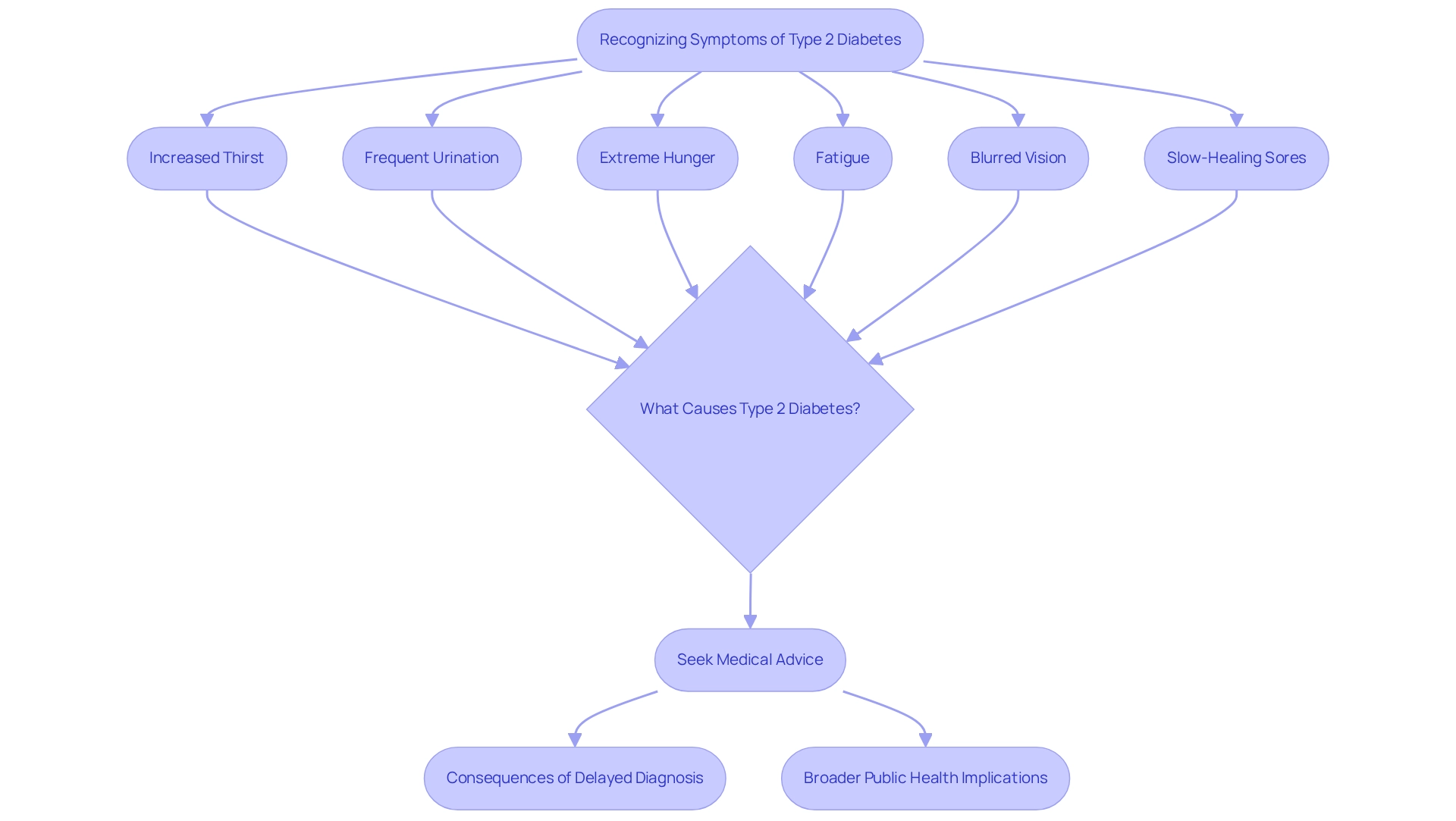
Identifying Risk Factors for Type 2 Diabetes
Understanding what causes type 2 diabetes is important, and it involves considering several risk factors, such as:
- Obesity
- Physical inactivity
- Family history
- Age
It's understandable to feel concerned about these factors. Being overweight is a significant risk factor; excess fat, especially around the abdomen, can increase insulin resistance. Additionally, people over the age of 45, those with a family history of diabetes, and those who lead sedentary lifestyles may find themselves at an elevated risk.
Recognizing these factors can empower you to make informed lifestyle decisions that may help reduce your risk of developing type 2 diabetes. You're not alone in this journey, and understanding these elements is the first step toward a healthier future. We are here to support you every step of the way.
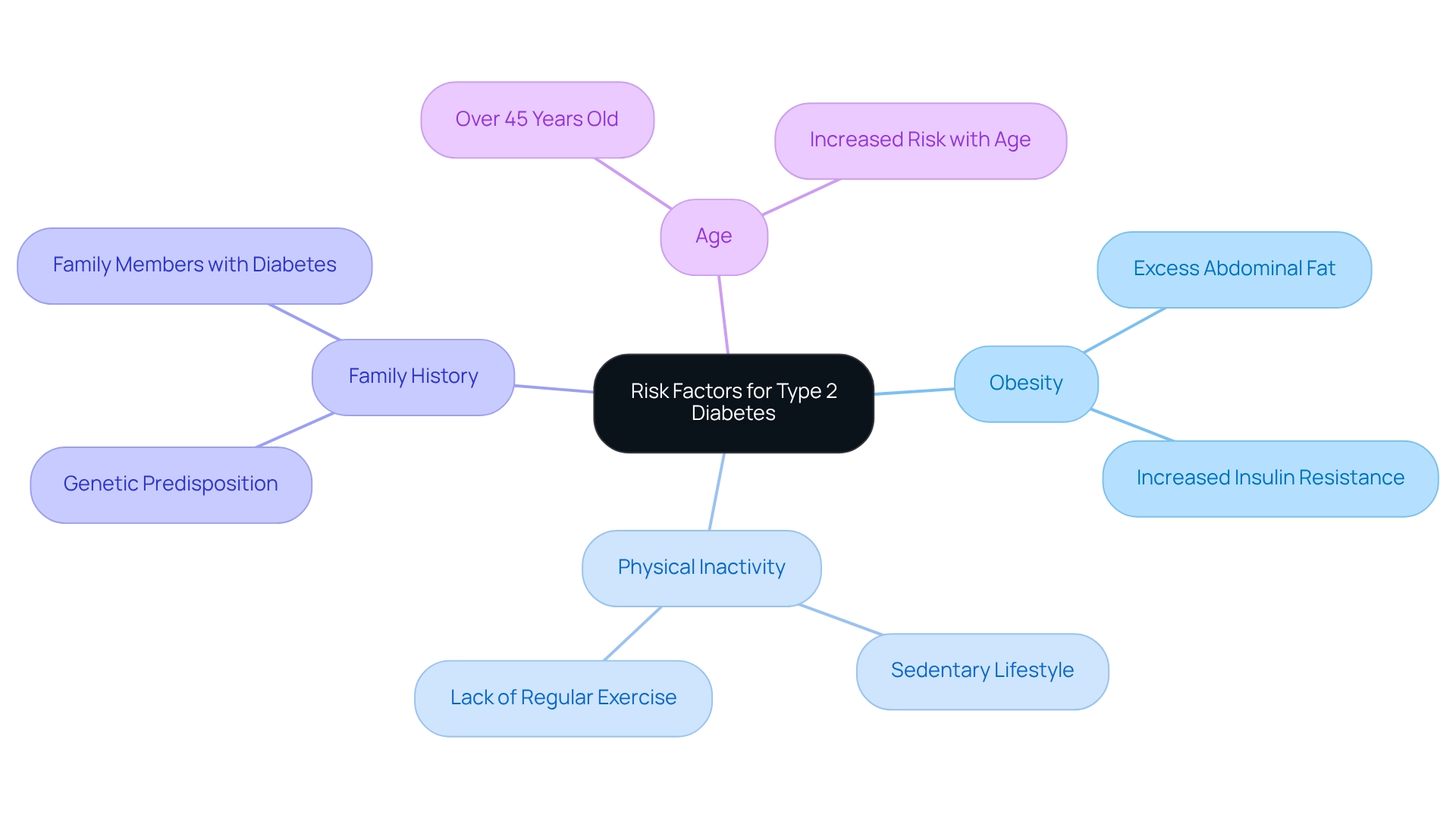
Exploring Triggers: What Leads to Type 2 Diabetes?
Understanding the range of factors that trigger Type 2 conditions, such as poor dietary choices, physical inactivity, and chronic stress, is crucial. You might wonder, what causes Type 2 diabetes? Diets high in processed foods, added sugars, and unhealthy fats significantly contribute to weight gain and insulin resistance—two critical risk factors for this disease. Studies show that individuals consuming large amounts of refined carbohydrates and sugary drinks face a heightened risk of developing Type 2 diabetes.
However, it’s important to know that dietary patterns prioritizing whole foods over processed options can help mitigate this risk.
Physical inactivity compounds these issues, as a sedentary lifestyle is linked to higher rates of obesity and insulin resistance. Engaging in consistent exercise not only aids in weight control but also enhances insulin sensitivity, making it an essential part of any diabetes prevention plan.
Chronic stress is another significant contributor to understanding what causes Type 2 diabetes. Stress can lead to hormonal changes that negatively affect blood sugar levels and insulin sensitivity, creating a challenging cycle. Individuals under high stress may turn to unhealthy eating habits, such as bingeing on comfort foods, which can further increase their risk.
Nutritionists emphasize the importance of stress reduction techniques, like mindfulness and physical activity, to help break this cycle and promote healthier lifestyle choices.
Real-life examples illustrate the effectiveness of stress management in diabetes prevention. For instance, individuals who engage in regular physical activity and practice stress-reduction techniques often report better blood sugar control and overall health. Furthermore, case studies highlight the necessity for dietary interventions, suggesting that clinicians and policymakers should prioritize healthier food options to combat the rising prevalence of Type 2 diabetes.
A relevant study titled "Implications for Health Policy and Nutrition" underscores the importance of addressing dietary habits to mitigate the global epidemic of Type 2 diabetes, projected to continue rising and impacting population health and economic productivity. As Meghan O’Hearn, Impact Director for Food Systems for the Future, stated, "These findings can help inform nutritional priorities for clinicians, policymakers, and private sector actors as they encourage healthier dietary choices that address this global epidemic."
As this global epidemic continues to escalate, understanding what causes Type 2 diabetes is essential for effective prevention and management. At T2DSolutions, we aim to be a valuable resource hub for newly diagnosed patients, providing education and community support to help individuals navigate these challenges. Our focus on community and collaboration underscores the belief that managing diabetes is a collective journey, where shared knowledge and support can lead to improved health outcomes for everyone involved.
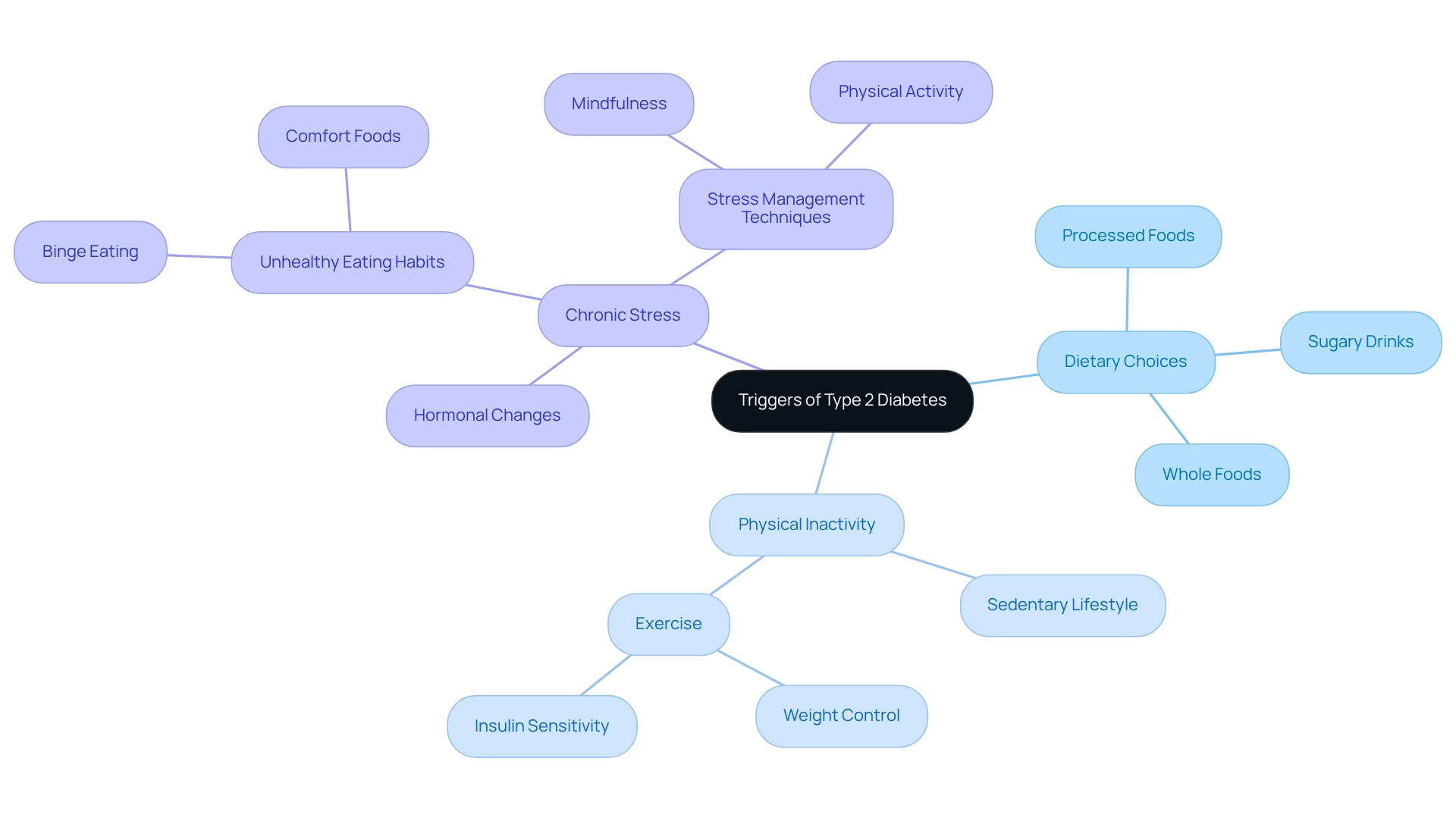
Unpacking the Causes of Type 2 Diabetes
The multifactorial causes of Type 2 diabetes, including genetic predisposition, lifestyle choices, and environmental influences, raise an important question: what causes type 2 diabetes? It's understandable to feel overwhelmed by this complexity. Genetic factors can indeed increase susceptibility, but lifestyle choices, such as diet and exercise, play a critical role in determining the risk. For instance, insulin resistance is often exacerbated by obesity and physical inactivity, leading to elevated blood sugar levels.
As we explore what causes type 2 diabetes, we must also consider environmental factors. Socioeconomic status and access to nutritious foods significantly influence the risk of developing this condition. It's essential to recognize that you're not alone in this journey; many people face similar challenges. As T2DSolutions launches as a fresh resource center for education on blood sugar management, we invite you to subscribe for updates. Together, we can navigate the complexities of Type 2 diabetes and find the support you need to thrive.
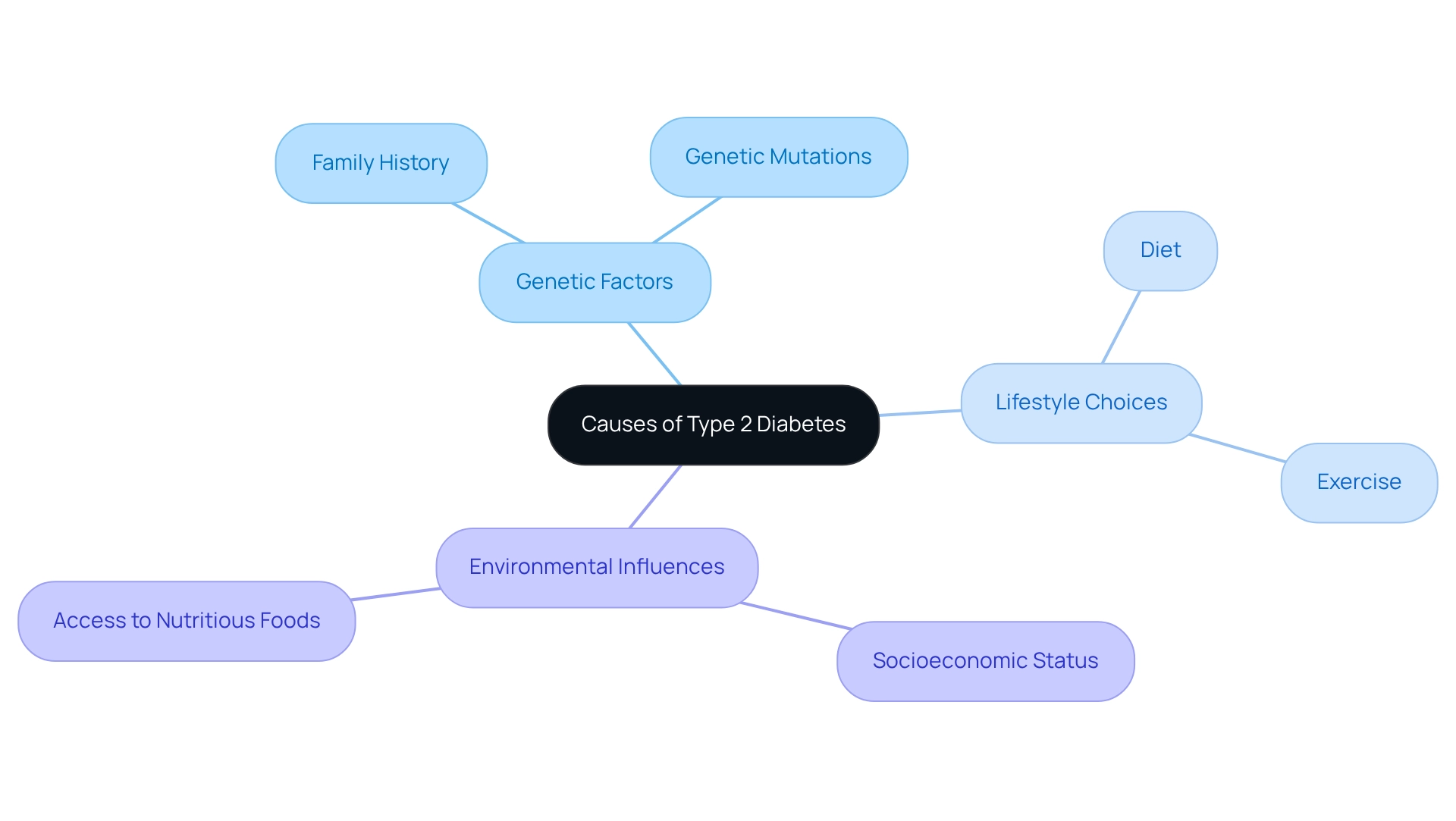
The Role of Testing in Early Detection of Type 2 Diabetes
Regular testing is essential for identifying what causes type 2 diabetes. This enables timely intervention, which can significantly reduce the risk of serious complications, including cardiovascular disease, nerve damage, and kidney issues. It's important to note that high blood glucose is responsible for around 11% of cardiovascular deaths, highlighting the severe consequences of unmanaged diabetes. Key tests for early detection include the A1C test, fasting plasma glucose test, and oral glucose tolerance test.
The A1C test is particularly valuable as it measures average blood sugar levels over the past two to three months. This provides a comprehensive view of a person's glucose management. In contrast, the fasting plasma glucose test evaluates blood sugar levels after an overnight fast, offering insights into immediate glucose control.
Statistics indicate that early detection rates through these testing methods can lead to improved health outcomes. For instance, individuals identified with prediabetes who adopt lifestyle changes—such as dietary adjustments and enhanced physical activity—can frequently avert the onset of type 2 diabetes. A case study emphasized that participants who received Diabetes Self-Management Education (DSME) within the past year reported improved skills in managing their condition. This underscores the significance of education alongside regular testing.
At T2DSolutions, we are committed to providing resources and support for newly diagnosed patients. Our platform offers educational resources, community assistance, and access to tools for health management. Healthcare professionals emphasize the importance of these tests.
Regular monitoring not only aids in early detection but also informs ongoing management strategies. For instance, A1C test results can guide adjustments in treatment plans, ensuring that patients maintain optimal blood sugar levels. As advancements in blood sugar testing techniques continue to emerge, the significance of regular testing remains crucial in the battle against type 2 diabetes, particularly in 2025 and beyond.
In summary, essential tests for early detection of type 2 diabetes include the A1C test, fasting plasma glucose test, and oral glucose tolerance test. These tools are vital for recognizing at-risk individuals and enabling prompt interventions that can lead to improved health outcomes. However, further research is needed to identify gaps in skills and self-efficacy among patients with blood sugar issues, which could enhance educational support programs.
As one participant noted, "My doctor doesn’t feel I need to be using a glucose meter to monitor my sugar levels and the educator doesn’t think I need to be on any sort of diet even though I’ve had increases in medications for my condition." This illustrates the challenges faced by individuals managing their health. Remember, you're not alone in this journey, and we are here to support you every step of the way.
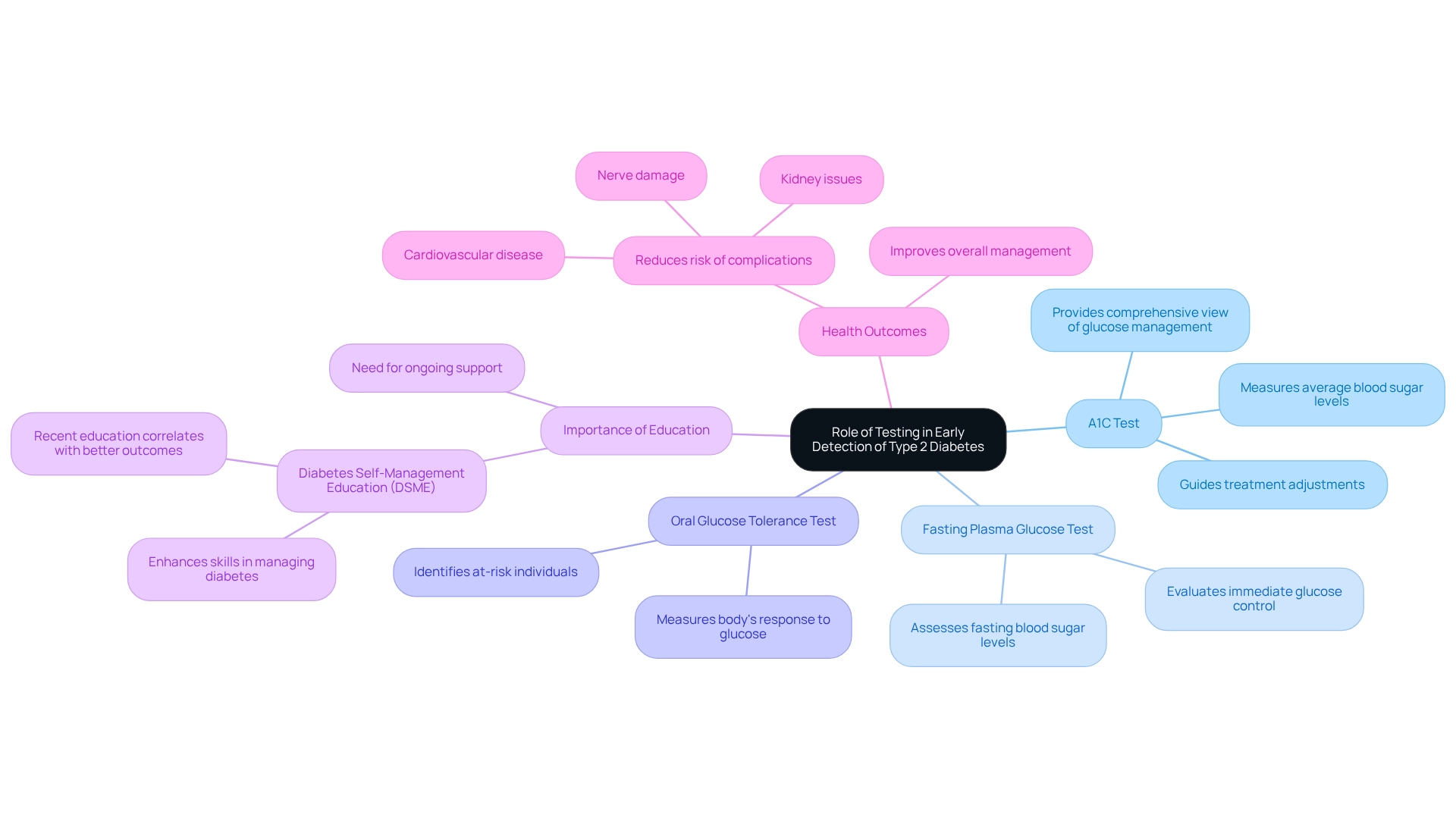
Managing Type 2 Diabetes: Strategies for Effective Care
To effectively manage Type 2 Diabetes, it's essential to understand its causes and adopt a holistic approach that includes lifestyle modifications, medication, and consistent monitoring. T2DSolutions serves as a valuable resource hub, offering diabetes education and community support to help newly diagnosed patients navigate their journey. Here are some key strategies:
- Balanced Diet: Emphasizing a diet rich in whole foods—like fruits, vegetables, whole grains, and lean proteins—can significantly impact blood sugar control. Studies show that individuals who adopt healthier eating habits often experience improved blood sugar levels and overall health. T2DSolutions provides resources for meal planning and nutritional guidance to assist you in making healthier choices.
- Regular Physical Activity: Engaging in consistent exercise not only helps with weight control but also improves insulin sensitivity. Even moderate activities, such as walking or cycling, can lead to significant enhancements in blood sugar control. T2DSolutions offers information on local exercise programs and community activities to encourage physical activity.
- Weight Management: Maintaining a healthy weight is crucial. For instance, a couple who shed a total of 118 pounds reported notable improvements in their blood sugar control without needing medication. This highlights how effective lifestyle changes can enhance health outcomes and address the question of what causes Type 2 Diabetes. T2DSolutions can connect you with support groups focused on weight management.
- Medication: While lifestyle changes are foundational, medications may be necessary for some individuals. Metformin, for example, is frequently prescribed to enhance insulin sensitivity and lower blood sugar levels effectively. T2DSolutions offers guidance on medication management and consultations with healthcare professionals.
Regularly checking your blood sugar levels helps you understand what causes Type 2 Diabetes and how your lifestyle choices influence your condition. This self-awareness is vital for making informed decisions about diet and activity. T2DSolutions emphasizes the importance of monitoring and provides tools to help you track your progress.
As we look ahead to 2025, effective strategies for managing Type 2 conditions continue to evolve, focusing on personalized care. Diabetes educators emphasize the importance of lifestyle modifications to understand what causes Type 2 Diabetes, noting that small, sustainable changes can lead to significant health benefits. As one educator stated, "Incorporating community support and sharing experiences can greatly enhance motivation and accountability in managing this health condition."
Real-world examples demonstrate the positive influence of medication and lifestyle changes on managing this condition, reinforcing the notion that a multifaceted approach is crucial for enhancing quality of life. By integrating these strategies and fostering connections within the community, you can take proactive steps toward managing your diabetes effectively with the support of T2DSolutions.

Building a Supportive Community for Diabetes Management
Building a supportive community is essential for individuals managing Type 2 Diabetes. Understanding what causes Type 2 Diabetes can be daunting, but T2D Solutions aims to be a vital resource on this journey. Support groups, online forums, and local resources provided by T2D Solutions offer invaluable information, encouragement, and shared experiences that can significantly enhance the care journey. Engaging with others facing similar challenges fosters a sense of belonging and alleviates feelings of isolation, especially in today's world where many have felt increased social disconnection.
Recent developments in diabetes support groups highlight their role in offering both emotional and practical assistance. Research indicates that individuals involved in support groups report enhanced coping strategies and improved adherence to treatment methods. This is particularly relevant as the pandemic has underscored the need for increased support, with studies showing that community engagement can lead to better health outcomes for those concerned about what causes Type 2 Diabetes.
In fact, combining peer support with conventional oversight strategies can lead to significant improvements in glycemic control. One study noted a remarkable 21% reduction in postprandial hyperglycemia when support is integrated with exercise and dietary changes.
Experts emphasize the necessity of personalized support systems. Leaders in managing blood sugar conditions advocate for tailored strategies that consider individual circumstances, including genetic factors and lifestyle. Zahalka SJ notes, "Ultimately, future therapy will need to be more personalized so that each person with the condition receives a specific prescription for exercise based on factors such as sex, type and duration of the illness, comorbidities, genetic background and exercise phenotype, and environment."
This tailored assistance is crucial in helping individuals navigate their unique challenges. Moreover, the HERITAGE Family Study illustrates the differences in exercise response among individuals, underscoring the need for personalized exercise plans in blood sugar control.
Real-life examples showcase the impact of community resources on diabetes management. Many individuals have found success through local support groups that not only provide emotional support but also encourage the sharing of practical advice and experiences. These interactions empower individuals to take charge of their health, leading to improved outcomes.
In conclusion, support groups are vital in understanding what causes Type 2 Diabetes, as they help enhance blood sugar control. By connecting individuals with shared experiences, these communities foster resilience and hope, ultimately contributing to a better quality of life for those affected by Type 2 Diabetes. T2D Solutions is committed to supporting these efforts, emphasizing the ongoing need for research on peer support interventions. This further highlights the evolving landscape of diabetes management and the importance of community support.
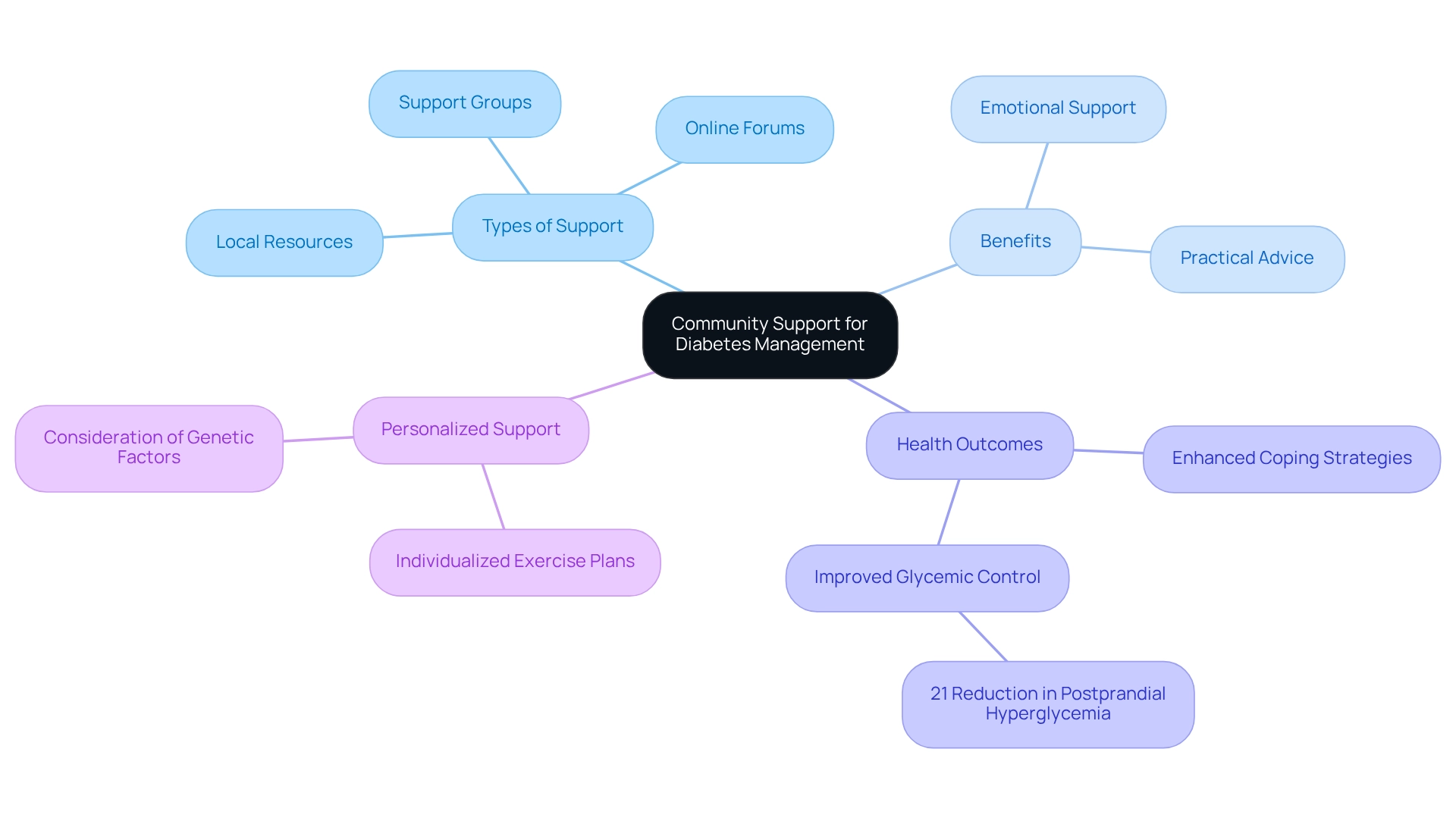
Conclusion
Understanding Type 2 Diabetes is critical in today's world, where its prevalence continues to rise, impacting millions globally. The multifaceted nature of this condition, characterized by insulin resistance and influenced by lifestyle choices, underscores the importance of awareness around its symptoms, risk factors, and management strategies. Recognizing early signs such as increased thirst and fatigue can lead to timely intervention. It's understandable to feel overwhelmed, but understanding personal risk factors like obesity and inactivity can help you make informed lifestyle choices to prevent the disease.
Moreover, the role of community and support cannot be overstated. Platforms like T2DSolutions provide essential resources and foster a supportive environment that encourages individuals to share their experiences and challenges. This communal approach not only combats feelings of isolation but also enhances motivation, leading to better health outcomes. The integration of lifestyle modifications, consistent monitoring, and personalized support systems plays a pivotal role in effective diabetes management.
As efforts continue to address this significant public health challenge, it is essential for you to stay informed and proactive in your health journey. By leveraging available resources and fostering a supportive community, managing Type 2 Diabetes becomes a shared endeavor. Remember, you’re not alone in this journey. Together, through education and support, we can navigate the path towards better health with confidence and resilience.
Frequently Asked Questions
What is Type 2 diabetes?
Type 2 diabetes is a chronic metabolic condition characterized by insulin resistance, where the body's cells struggle to respond effectively to insulin, leading to elevated blood sugar levels and potential health complications.
How does Type 2 diabetes differ from Type 1 diabetes?
Unlike Type 1 diabetes, where the pancreas produces little to no insulin, Type 2 diabetes often develops gradually and is closely linked to lifestyle factors such as diet, physical activity, and obesity.
How prevalent is Type 2 diabetes globally?
Type 2 diabetes is the most common form of diabetes worldwide, affecting approximately 422 million people, with about 90% of these cases being Type 2.
What are some significant health risks associated with Type 2 diabetes?
Individuals with Type 2 diabetes may face serious health complications, including cardiovascular disease, especially due to insulin resistance and poor blood sugar control.
What role does physical activity play in managing Type 2 diabetes?
Physical inactivity is a significant barrier to effective blood sugar control, with many adults diagnosed with Type 2 participating in insufficient exercise, highlighting the need for enhanced physical activity programs.
What are common symptoms of Type 2 diabetes?
Common symptoms include increased thirst, frequent urination, extreme hunger, fatigue, blurred vision, and slow-healing sores.
Why is early recognition of Type 2 diabetes symptoms important?
Early recognition can facilitate prompt diagnosis and treatment, significantly impacting the management of the condition and reducing the risk of serious complications.
What are some lifestyle modifications that can help prevent Type 2 diabetes?
Adopting a balanced diet and increasing physical activity are essential lifestyle modifications that can help prevent Type 2 diabetes.
How does the burden of Type 2 diabetes manifest in specific regions, such as Tunisia?
In Tunisia, the impact of Type 2 diabetes is reflected in the Disability-Adjusted Life Years (DALY) count, which is 152,000, indicating a considerable public health burden.
What resources are available for individuals diagnosed with Type 2 diabetes?
T2DSolutions aims to serve as a comprehensive resource center, offering educational resources, support networks, and professional guidance to help individuals understand their symptoms and manage their health journey.
